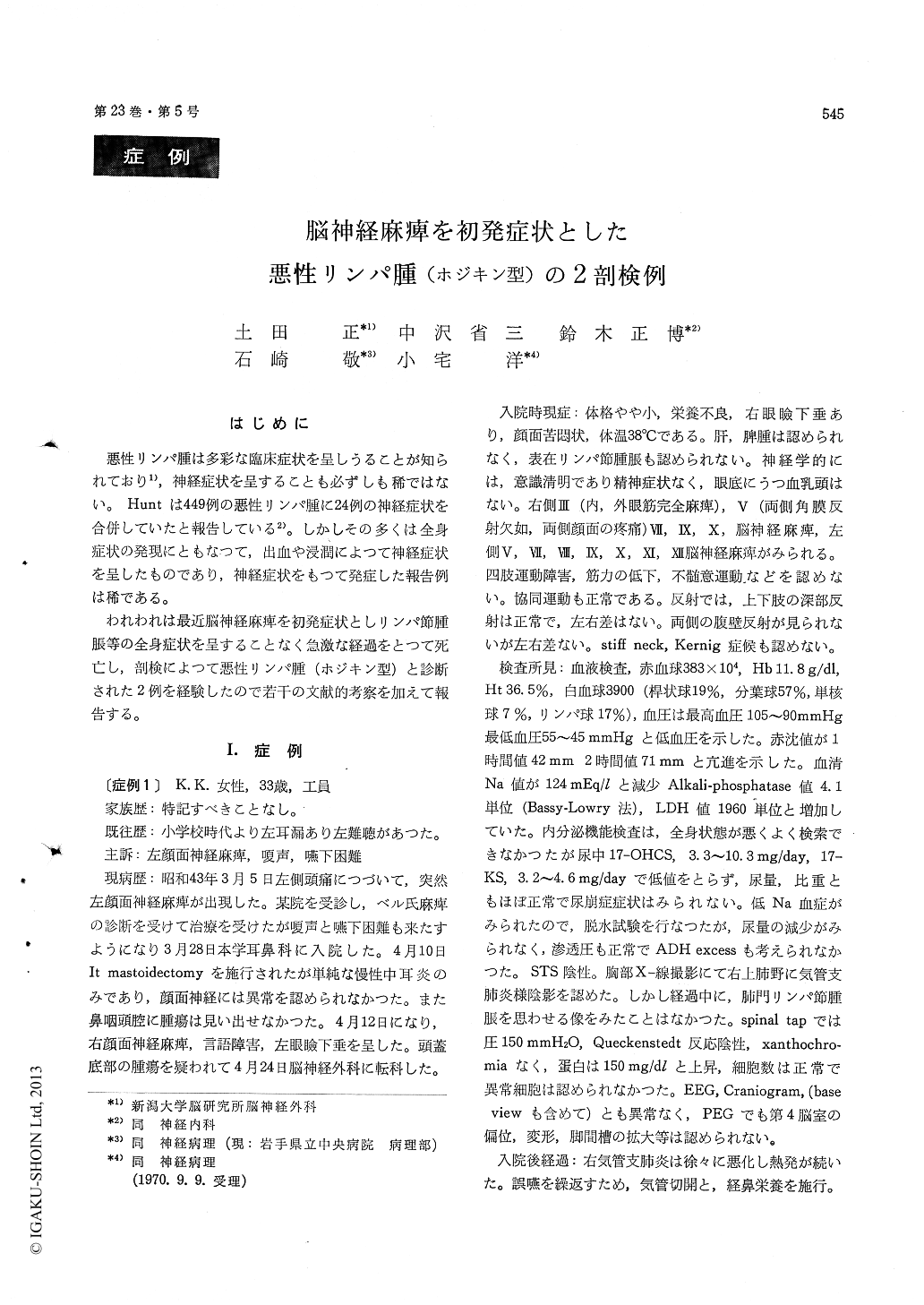Japanese
English
- 有料閲覧
- Abstract 文献概要
- 1ページ目 Look Inside
はじめに
悪性リンパ腫は多彩な臨床症状を呈しうることが知られており1),神経症状を呈することも必ずしも稀ではない。Huntは449例の悪性リンパ腫に24例の神経症状を合併していたと報告している2)。しかしその多くは全身症状の発現にともなつて,出血や浸潤によつて神経症状を呈したものであり,神経症状をもつて発症した報告例は稀である。
われわれは最近脳神経麻痺を初発症状としリンパ節腫脹等の全身症状を呈することなく急激な経過をとつて死亡し,剖検によつて悪性リンパ腫(ホジキン型)と診断された2例を経験したので若干の文献的考察を加えて報告する。
Two cases multiple cranial nerve involvement are described.
Case 1: The patient was a 33-year-old female, who complained of sudden left facial palsy two months before her death. One month later from that time, she suffered from multiple cranial nerve palsy (It-III,,V, VII, X, XI, XII, rt-III, V, VII, VIII, X), but no lymphadenopathy was seen. Post-mortem examination revealed swelling of these cranial nerves and enlargement of the bilateral adrenal gland and ovaries [Fig. 1-a, b, c].
On histological examination, these cranial nerves were infiltrated with lymphoma cells. The bilateral adrenal glands and ovaries were occupied with tumor cells which were consisted of lymphocytes, histiocytes and atypical reticular cells with large eosinophilic nucleoli [Fig. 1-d, e, f]. Vasculitis and perivasculitis were present in the tumor tissue.
Case 2: The patient was a 53-year-old male. Initial symptoms were rt. facial and rt. hypoglossal nerve palsy. Four months before his death, rt-III, VI, VII, XII, It-VI, V, cranial nerve palsy, motor weakness and sensory disturbance of legs were observed.
Post-mortem examination revealed elevation of the floor of third ventricle and slight thickening of the basal leptomenings. Tumor nodules were seen in the right thalamus, midbrain, cerebellum and cauda equina [Fig. 2-a, b].
On histological examination, lymphoma cells with pleomorphism were observed in the tumor nodules. Furthermore, tumor cells infiltrated the cranial nerves, spinal roots, subarachnoid space, pituitary posterior lobe and siatic nerves [Fig. 2-c, d, e].
Malignant lymphoma is known to be combined with various neurological signs [Table 1]. We emphasize that there are three clinico-pathologicaltypes in malignant lymphoma with intracranial manifestation.
Type 1: systematic lymphadenopathy with neurological signs.
Type 2: solitary brain tumor (predominatly in primary brain reticulosar-coma).
Type 3: cranial neuropathy and/or brain invo- lvement without general symptoms.
Our two cases belong to Type 3. This type is very rare and very difficult in diagnosis. Five cases of this type are summerized in Table 2.

Copyright © 1971, Igaku-Shoin Ltd. All rights reserved.


